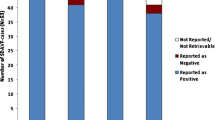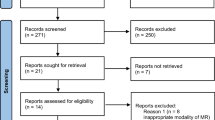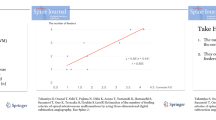Abstract
Purpose
To evaluate spinal MRIs without and with 3D T2W imaging among patients without and with spinal dural arteriovenous fistula (SDAVF) confirmed by spinal digital subtraction angiography (DSA).
Methods
A retrospective case-control study was performed among patients without and with SDAVF who had both spinal MRIs and gold standard spinal DSA. Two neuroradiologists independently reviewed spinal MRIs that were performed with either sagittal T2W turbo spin echo (2D group) or sagittal 3D T2W sampling perfection with application-optimized contrasts using different flip-angle evolutions (SPACE) (3D group) and documented the presence or absence of SDAVF. Using spinal DSA diagnosis as a gold standard, the sensitivity, specificity, and interobserver agreement for the 2D-group and 3D-group MRI diagnosis were calculated.
Results
The 2D group consisted of 21 patients and the 3D group consisted of 16 patients. For both radiologists, the 2D group demonstrated a sensitivity of 100% and specificity of 100%. Interobserver agreement in the 2D group was perfect (k = 1.0). For both radiologists, the 3D group demonstrated sensitivity of 100.0% and specificity of 92.3%. Interobserver agreement in the 3D group was perfect (k = 1.0). While flow voids were considered more conspicuous, spinal cord signal abnormality was considered less conspicuous with 3D T2W SPACE compared with conventional 2D STIR sequence.
Conclusion
3D T2W SPACE should be used in conjunction with 2D T2W sequences to more accurately detect abnormal cord signal and determine when perimedullary flow voids are pathologically abnormal for the radiologic diagnosis of SDAVF.



Similar content being viewed by others
Abbreviations
- SDAVF:
-
Spinal dural arteriovenous fistula
- DSA:
-
Digital subtraction angiography
- SPACE:
-
Sampling perfection with application-optimized contrasts using different flip-angle evolutions
- CISS:
-
Constructive interference in steady state
- FIESTA:
-
Fast imaging employing steady-state acquisition
References
Krings T, Lasjaunias PL, Hans FJ et al (2007) Imaging in spinal vascular disease. Neuroimaging Clin N Am 17:57–72
Toossi S, Josephson SA, Hetts SW et al (2012) Utility of MRI in spinal arteriovenous fistula. Neurology 79:25–30
Krings T, Geibprasert S (2009) Spinal dural arteriovenous fistulas. AJNR Am J Neuroradiol 30:639–648
Kannath SK, Alampath P, Enakshy Rajan J et al (2016 Jul) Utility of 3D SPACE T2-weighted volumetric sequence in the localization of spinal dural arteriovenous fistula. J Neurosurg Spine 25(1):125–132
Rizvi T, Garg A, Gupta V et al (2004) Role of CISS MR sequence in detection of spinal dural arteriovenous fistula. Case Rep Clin Radiol Extra 59:78–82
Morris JM, Kaufmann TJ, Campeau NG et al (2011) Volumetric myelographic magnetic resonance imaging to localize difficult-to-find spinal dural arteriovenous fistulas. J Neurosurg Spine 14:398–404
Kannath SK, Thomas B, Sankara Sarma P, et al 2016 Impact of non-contrast enhanced volumetric MRI-based feeder localization in the treatment of spinal dural arteriovenous fistula. J Neurointerv Surg 9(2):178–182
Landis JR, Koch GG (1977) The measurement of observer agreement for categorical data. Biometrics 33:159–174
Alhilali LM, Reynolds AR, Fakhran S (2014 Jun 6) Value of prominent flow voids without cord edema in the detection of spinal arteriovenous fistulae. PLoS One 9(6):e99004
van Rooij WJ, Nijenhuis RJ, Peluso JP et al (2012 Nov) Spinal dural fistulas without swelling and edema of the cord as incidental findings. AJNR Am J Neuroradiol 33(10):1888–1892
Author information
Authors and Affiliations
Corresponding author
Ethics declarations
Funding
No funding was received for this study.
Conflict of interest
The authors declare that they have no conflict of interest.
Ethical approval
All procedures performed in the studies involving human participants were in accordance with the ethical standards of the institutional and/or national research committee and with the 1964 Helsinki Declaration and its later amendments or comparable ethical standards. For this type of study formal consent is not required.
Informed consent
For this type of retrospective study formal consent is not required.
Rights and permissions
About this article
Cite this article
Kralik, S.F., Murph, D., Mehta, P. et al. Diagnosis of spinal dural arteriovenous fistula using 3D T2-weighted imaging. Neuroradiology 59, 997–1002 (2017). https://doi.org/10.1007/s00234-017-1893-0
Received:
Accepted:
Published:
Issue Date:
DOI: https://doi.org/10.1007/s00234-017-1893-0




